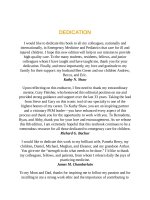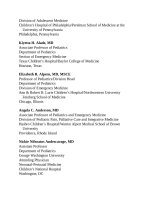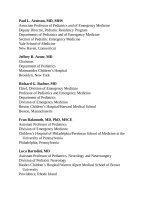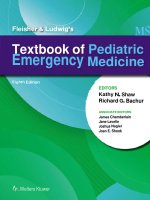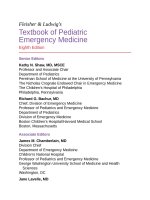Pediatric emergency medicine trisk 815
Bạn đang xem bản rút gọn của tài liệu. Xem và tải ngay bản đầy đủ của tài liệu tại đây (209.67 KB, 4 trang )
FIGURE 105.3 Fracture of the upper right central incisor. Dentin involvement identified by the
yellow coloration within the fracture surface.
FIGURE 105.4 Pulp exposure can be seen as pink blush within the fracture surfaces.
CHAPTER 106 ■ ENT TRAUMA
MICHELLE L. NIESCIERENKO, GI SOO LEE
GOALS OF EMERGENCY THERAPY
General Goals
Trauma to ear, nose, and throat can range from minor to life-threatening, which
can be secondary to airway compromise, or in some cases blood loss. Beyond the
immediate risk, secondary complications can include infection of vital structures
or compromise of vasculature secondary to damage. The goal of emergency care
is immediate recognition of injuries that may result in airway or hemodynamic
compromise and prompt involvement of an otolaryngologist or pediatric surgeon.
Clinicians should balance invasive diagnostic testing with the goal of limiting
secondary complications resulting from the injury, which include infection,
hematoma, or cosmetic deformity.
RELATED CHAPTERS
Signs and Symptoms
Dizziness and Vertigo: Chapter 24
Epistaxis: Chapter 26
Foreign Body: Ingestion and Aspiration: Chapter 32
Hearing Loss: Chapter 34
Injury: Head: Chapter 41
Respiratory Distress: Chapter 71
Medical, Surgical, and Trauma Emergencies
Toxicologic Emergencies: Chapter 102
Dental Trauma: Chapter 105
Facial Trauma: Chapter 107
Minor Trauma: Chapter 110
Neurotrauma: Chapter 113
The Children’s Hospital of Philadelphia Clinical Pathway
ED Clinical Pathway for Evaluation/Treatment of Acute Head
Trauma
URL: />Authors: M. Zonfrillo, MD; F. Nadel, MD; D. Corwin, MD; M. Mittal, MD;
C. Jacobstein, MD; J. Lavelle, MD; P. Scribano, DO, MSCE
Posted: December 2010, last revised February 2020
TRAUMA TO THE EAR
Ear Foreign Body
Goals of Treatment
The goal of treatment is to remove the foreign body as early after it is recognized
as possible. Early removal allows for the easiest possible extraction which
reduces risk of trauma to the external canal and tympanic membrane (TM).
Removal of the foreign body prevents infection, damage to the TM, and can
prevent hearing compromise.
CLINICAL PEARLS AND PITFALLS
Examine the ear with caution to avoid advancing the object further into
the canal.
Be sure to check other orifices for additional foreign bodies.
Disk batteries should be removed as soon as they are identified to
avoid rapid tissue destruction.
Kill insects in the external auditory canal (EAC) using mineral oil or
alcohol before attempting removal. Note, if the animal has caused
abrasions of the ear canal skin, alcohol can be significantly painful if
used.
Irrigation of biologic foreign bodies can result in swelling of the object
and cause them to become more firmly lodged in the auditory canal.
Current Evidence
Foreign objects in the EAC are a common occurrence in children with nearly
10,000 visits annually. Children with ADHD or kinetic movement disorders are at

